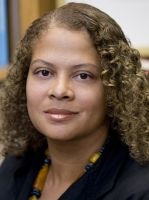The University of Iowa College of Law offered its Law in the Muslim World class for the first time in 2002, and one of its major focuses was on the terrorist attacks of the previous September.
When it was offered again in 2003, the development of Iraq’s first post-Saddam constitution was emphasized.
The class is offered again this spring, and this time a focus is on the aftermath of the Arab Spring and the ongoing upheaval in countries like Egypt and Syria.

“It’s not like teaching Elizabethan history,” says professor Adrien Wing, who teaches the class at UI, and during the law school’s summer session in Arcachon, France. “The content is affected every semester that I teach it, sometimes in the middle of the semester.”
The class surveys a selection of the various types of law that govern the approximately 60 countries in the world where the majority or a sizable minority of the people are Muslims. How those countries incorporate Islam into their law varies. At one end of the spectrum, Saudi Arabia uses a very strict form of shari’a Islamic law that calls for strict criminal punishments and requires women to be veiled and prohibits them from driving cars. But only a few Muslim countries use that kind of shari'a. Tunisia, for instance, has been relatively secular and uses codes that are little influenced by Islamic teachings.
How each Muslim country incorporates Islam into its laws depends on its own history and culture, Wing says. In Turkey, for instance, the country’s founder, Kemal Ataturk, was committed to creating a western style secular democracy that protects civil and political rights, and has mostly stuck to that philosophy. Right now, she says it’s playing a major political and diplomatic role in its region, and has a booming economy.
But Wing says that change is a constant, and perceptions change a lot from one class to the next. When she taught Law in the Muslim World two years ago, the Arab Spring was underway and seen mostly as a positive example of the people coming together to topple brutal dictators in countries like Egypt and Tunisia, creating the hope that true democracy could take root in the Middle East. There were questions and concerns, she says, but great promise for the future.
Now, she says, the promise may be mostly lost—at least from a western perspective. Democratic elections have led to the installation of Islamist governments that are putting in place constitutions reflecting beliefs that, for example, will be more limiting in areas like women’s rights.
“Egypt and Tunisia, they’re going backwards on civil rights,” she says, suggesting that as far as women are concerned, the Arab Spring is becoming more like the Arab Fall.
As an example of how much the Muslim world has changed in the decade Wing’s been teaching the course, the Taliban has been driven from power in Afghanistan and Osama Bin Laden has been killed. Saddam Hussein and Muammar Gadaffi, both entrenched in Iraq and Libya respectively for decades, have both been deposed and executed. And most surprisingly of all is that Hosni Mubarak of Egypt—one of the strongest of strongmen in any Muslim country—was forced to abdicate, then put on trial and convicted for human rights violations. Now sick and marginalized, he can no longer hope of passing on his legacy to his son.
“Ten years ago, Mubarak was not seen as someone who would be toppled,” Wing says. “A month before he was overthrown, Mubarak was not seen as someone who would be toppled.”
Now, the forces of change in the Islamic world are focused on Syria, where the Assad regime is fighting a bloody civil war to put down an insurgency throughout the country. Wing predicted the situation in a way during her class several years ago, when she asked a test question about what might happen if Syria descended into civil war after the Assad regime was toppled.
“That might be a question we have to answer again during this semester,” she says.